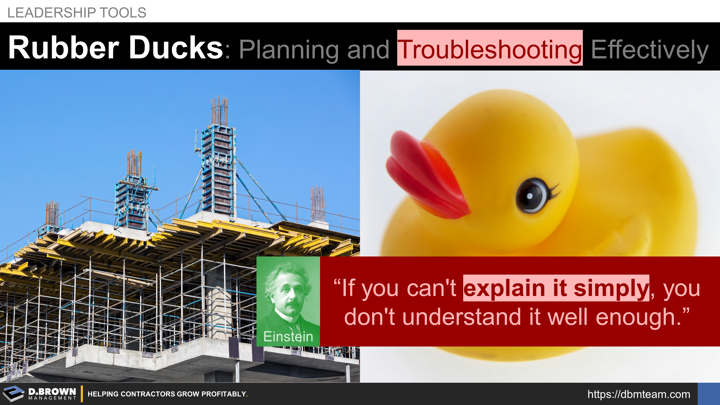The concept of "Rubber Duck" was introduced in the 1999 book, The Pragmatic Programmer as a methodology for troubleshooting computer code.
The approach was simple and based upon experiences that many of us have had where we are in the middle of explaining a problem to someone else who may not even know that much about the problem and while in the middle of explaining it, we hit upon a solution.
In describing the expected outcomes and the observations of what is actually going on in detail, the definition of the problem becomes clearer as does the solution. More generally, teaching a subject forces evaluation from different perspectives, providing much deeper understanding for the teacher. This is especially true when teaching someone who doesn't have the same context and experience that the teacher does.
By using an inanimate object such as a rubber duck and going through the same process of explaining a problem or teaching something, you can achieve better results than merely trying to think about it yourself.
This is not a new concept but the visual of a Rubber Duck is a great reminder.
How does this apply for building projects and building construction businesses?
The same basics apply whether you are a Foreman communicating the ABC's of your Daily Work Plan to the crew, an Operations Manager communicating the Change Management Workflow to your PMs, or the CEO communicating your Strategic Market Choices to the team.
Success at any of those levels of communication of a plan is largely dictated by how effectively the least experienced person on the team understands what is expected, why, how, and by when. Think about this least experienced person as a Rubber Duck when preparing and practicing your communication.
Great coaches from Vince Lombardi to John Wooden use that as a foundational principle for how they coach. They take nothing for granted and assume that no knowledge is carried over from past games and years, they start with the fundamentals like how to properly tie shoes (Wooden) and methodically going through the playbook, starting at page one.
Communication Clarity are words frequently used together with great intent but with sloppy definitions and process.
Remember that effective communication starts with five questions:
- What information must be communicated? Minimum, maximum, and optimal amounts?
- Who must that information be communicated to?
- When must that information be communicated? Earliest, latest, and optimal timing? Frequency if it must be repeated often like safety or other leadership messages?
- How is that information best communicated? Is there a standard format and method?
- How will you confirm that the information was received and understood?
See The Four Elements of Commander's Intent for additional clarity on communication throughout an organization.
Remember that communication and trust go hand-in-hand. Consistent communication builds trust and trust is a foundation that makes communication more effective.
There is a special kind of Rubber Duck that can be invaluable for accelerating team growth. That is the Rubber Duck that is very experienced yet can comfortably put themselves in the shoes of that least experienced person and ask "Good Questions" of the team as they are explaining the plan.
That is one of the most effective uses of an experienced but unbiased 3rd party. They can often help you see your problems and plans from a different perspective which is invaluable for navigating growth.
All relationships begin with a simple conversation.

